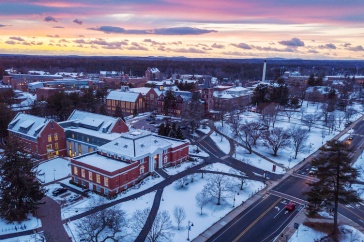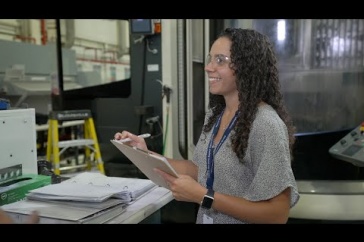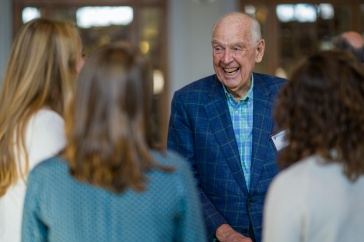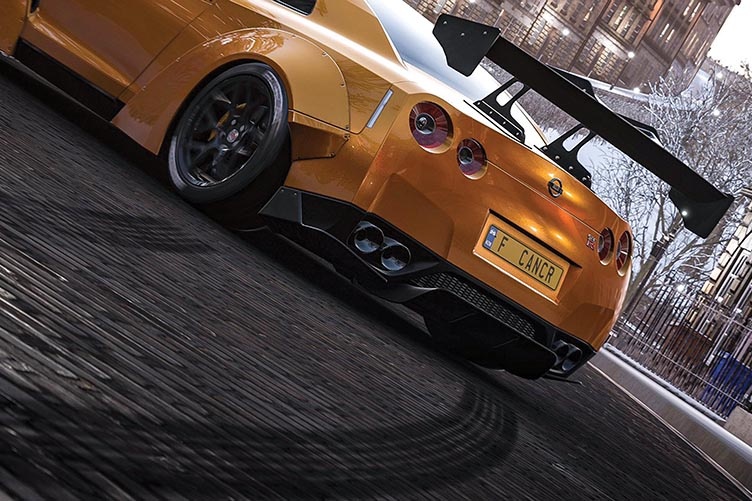
LAST FALL, when medical tests revealed that Dawn Cockrum’s 8-year-old daughter, Lily, was at high risk for a rare disease called hereditary leiomyomatosis and renal cell cancer (HLRCC), the Winston-Salem, North Carolina, resident reached out to Bruce Lee in Kensington, Maryland. Lily’s local doctors had never before encountered HLRCC, had no idea how to treat it — and weren’t quite sure how to connect the Cockrums with Maryland’s National Institutes of Health, the closest center with specialists for the disease.
Lee isn’t one of those specialists, however. He’s the father of the late Andrew Lee ’18, who received an HLRCC diagnosis in May 2015, at the end of his fresh- man year at UNH. Initially given six months to a year to live, Andrew had a heart-to-heart with his father, who asked him what his life goals were, given that his time was limited.
“Andrew told me he’d love to have a great job like mine so he could buy his dream car, a Nissan GT-R,” Lee recalls. “I asked him, ‘a GT-R? what’s that?’”

Lee soon found out. He deliberated for less than a day before deciding to buy his son the luxury sports car, which attracted attention wherever Andrew went, and it wasn’t long before Andrew realized his new vehicle could be a vehicle — to raise awareness about and money to support research for HLRCC. When Andrew died on April 21, 2019, nearly four years after his diagnosis, his dream car had become the basis of a nonprofit organization, Driven To Cure (DTC), that has raised more than $600,000 for research on HLRCC and other rare kidney cancers and become a source of information about the disease for individuals and families.
“When Dawn Cockrum reached out to me, one of the first things she said was, ‘any time you search online for HLRCC, the first thing that comes up is Driven To Cure,’” Lee explains.
And that’s only the beginning of the legacy of Andrew Lee.
“Let’s find a cure”
Andrew grew up in the D.C. suburb of Kensington, the least-memorably named member of a family that includes not only father Bruce but also mother Sarah and brother Tommy. An avid soccer player and golfer, Andrew had always figured he’d head south for college, but he was “intrigued” by UNH’s location — an easy drive to ski mountains and to the ocean, two destinations he particularly loved — as well as the strength of the Peter T. Paul College of Business and Economics.
“He liked the fact that at UNH, you could jump into business courses right away,” Lee recalls.

The head of a family-owned real estate development company, Lee says that Andrew, a business administration major, had planned to come work with him after college and eventually own and operate his own real estate brokerage firm, and to that end Andrew had spent his freshman spring break registering for summer real estate licensing courses. That plan went out the window when the excruciating abdominal pain Lee found his son in the day he came to collect Andrew from UNH turned out to be not appendicitis, as initially suspected, but internal bleeding, caused by a cancerous tumor that had eroded through his kidney wall. He was quickly transferred from Wentworth-Douglass Hospital in Dover to Boston’s Massachusetts General Hospital, where David Sweetser, MD, the chief of medical genet- ics, made the devastating diagnosis of HLRCC.
“Dr. Sweetser told us, ‘I think I know what this is, and I think it’s really bad,’” Lee says. “Andrew had about 20 minutes of ‘why me?’ but then it was like a faucet turning off. After that, it was just, ‘Dad, let’s beat this. Let’s find a cure.’”
HLRCC falls under the heading of rare genetic disorders. Caused by a mutation in one copy of the fumarate hydratase (FH) gene — everyone has two — it typically manifests as benign smooth muscle tissue tumors (leiomyomas) that can appear anywhere on the body; in only approximately 0.1 percent of cases does HLRCC develop into cancerous kidney tumors. According to the U.S. National Library of Medicine, HLRCC cancer is so rare, it’s only been diagnosed in about 100 families worldwide. When Andrew’s was diagnosed at Mass General in late May 2015, both of his kidneys were already riddled with cancer and there was a tumor in his pelvic bone. He was considered stage 4, the most advanced.

As of now, HLRCC has no known cure, but Mass General’s Sweetser knew that the National Institutes of Health (NIH) was the one place in the United States that was having success stabilizing patients and limit- ing the spread of their cancer. It also happened to be in the Lees’ back yard, and within short order Andrew was enrolled in a clinical trial that kept him stable for nearly 18 months — far longer than he’d originally been told he would survive. He got his GT-R, and he returned to UNH to complete the first semester of his sophomore year, flying home to Maryland every other weekend for treatment.
The side effects of the treatment were challenging, however, and after a semester of juggling treatments and a full schedule of business management courses, Andrew realized he needed to take a different approach. He’d already begun taking his GT-R to car shows, where the reason for his owning it inevitably came up, and the idea of turning the car into a nonprofit to raise money and awareness started to take hold. He came up with the name and a slogan — “Built to drive, driven to cure” — secured the Driven To Cure domain name for $7.99, and in January 2016 approached Paul College professor Andrew Earle about enrolling in what was then an experimental course for entrepreneur- ship-minded students, “Launching New Ventures,” to formalize his fundraising efforts.

With Earle’s guidance, Andrew developed a formal business plan, built the Driven To Cure website, designed logos, branding and social media, created a board of directors and filed the paperwork to incorporate as a 501(c)3 nonprofit. By that April, Driven To Cure was officially open for business, selling merchandise (T-shirts, sweatshirts and hoodies, wristbands, decals and stickers) emblazoned with the DTC logo. With average donations in the $50 range, the organization raised a remarkable $200,000 its first year, which Andrew donated to NIH. There, it supports the work of W. Marston Linehan, MD, chief of urologic surgery and urologic oncology, who pioneered the study of the genetic basis of kidney cancer and is developing new approaches to treat multiple forms of the disease.
Finding meaning
From the start, Andrew knew that his cancer was incurable, but he found purpose and meaning in making a difference for others. To that end, he enrolled in some seven clinical trials through the NIH, Yale University’s Smilow Cancer Center and Georgetown’s Lombardi Cancer Center. He and his family also felt strongly that all of the money raised by DTC go toward research, even when the trial protocols he was on stopped work- ing and they needed to pursue avenues of treatment not covered by insurance — to the tune of multiple thousands of dollars a month.
“It’s a question that’s come up before,” Lee acknowledges. “Why didn’t you use the proceeds from Driven To Cure to pay for Andrew’s treatments?” Lee says that Andrew understood he came from a privileged background, and that his family could find ways to cover his treatments, even if those ways were financially burden- some. “He knew there were other people out there for which that simply wasn’t an option. His goal was always to help others.”

That help took a wide variety of forms, including sharing his GT-R, painted a custom orange for kidney cancer, with as many people as possible. He frequently brought the car to the Children’s Inn at NIH — the residential facility where patients stay with their parents while undergoing treatment in clinical trials — to take his fellow patients joyriding. Among those with whom he became close was 15-year-old Isaac Barchus of Omaha, Nebraska, who suffers from a rare autoinflammatory disease for which he receives treatment at NIH. Not only did Isaac and Andrew bond over long rides and conversations in Andrew’s GT-R, when Andrew’s cancer progressed to the point he required a wheelchair to get around, he chose a model that would work for Isaac, too, knowing he’d only be using it for a limited time. Last June, less than two months after Andrew’s death, Lee delivered the chair to the Barchus family, refurbished with DTC orange paint and emblazoned with a replica of the GT-R’s thumb-to-the-nose FCANCR license plate. In 2017, the state of Maryland recognized Andrew’s generosity with the Montgomery County William Donald Schaefer Helping People Award. A year later, he was honored by the Foundation at the NIH with its Charles A. Sanders, MD, Partnership Award for his “unwavering commitment to advancing biomedical research on rare kidney cancers.”
Trailblazer
Though the advance of his cancer — coupled with the success of Driven To Cure, which has raised more than $100,000 per year since its 2016 launch — meant Andrew ultimately had to give up his studies at UNH, he’s had a lasting impact on Paul College. The only sophomore among a group of seniors in Earle’s spring 2016 “Launching New Ventures” class, his success with Driven To Cure was among the proof points that helped the course earn a permanent spot in the curriculum; today, it’s the senior capstone course for business students in the entrepreneurial studies option.
“That first class was essentially structured as a group of independent studies that all met together,” recalls Earle, noting that the majority of his students came in with ideas in the consumer products and high-tech realm. “Driven To Cure was the only nonprofit, socially oriented initiative, and in that respect it provided a great template for what the work coming out of the class could be and do. It’s become the most successful project to come out of the class by far. Andrew really left a remarkable legacy.”
He’s also had a lasting impact at NIH. “I think it’s his humanity that touched us the most,” says NIH Director Francis Collins, MD, who met Andrew when he made his first DTC donation to the institute and became a friend thereafter. “He always had time to share his story, to encourage another child or adult struggling with a frightening diagnosis.” And of course, “He’d give thrills to the kids at The Children’s Inn at NIH when he rumbled into the parking lot with his 700-horsepower GT-R.”
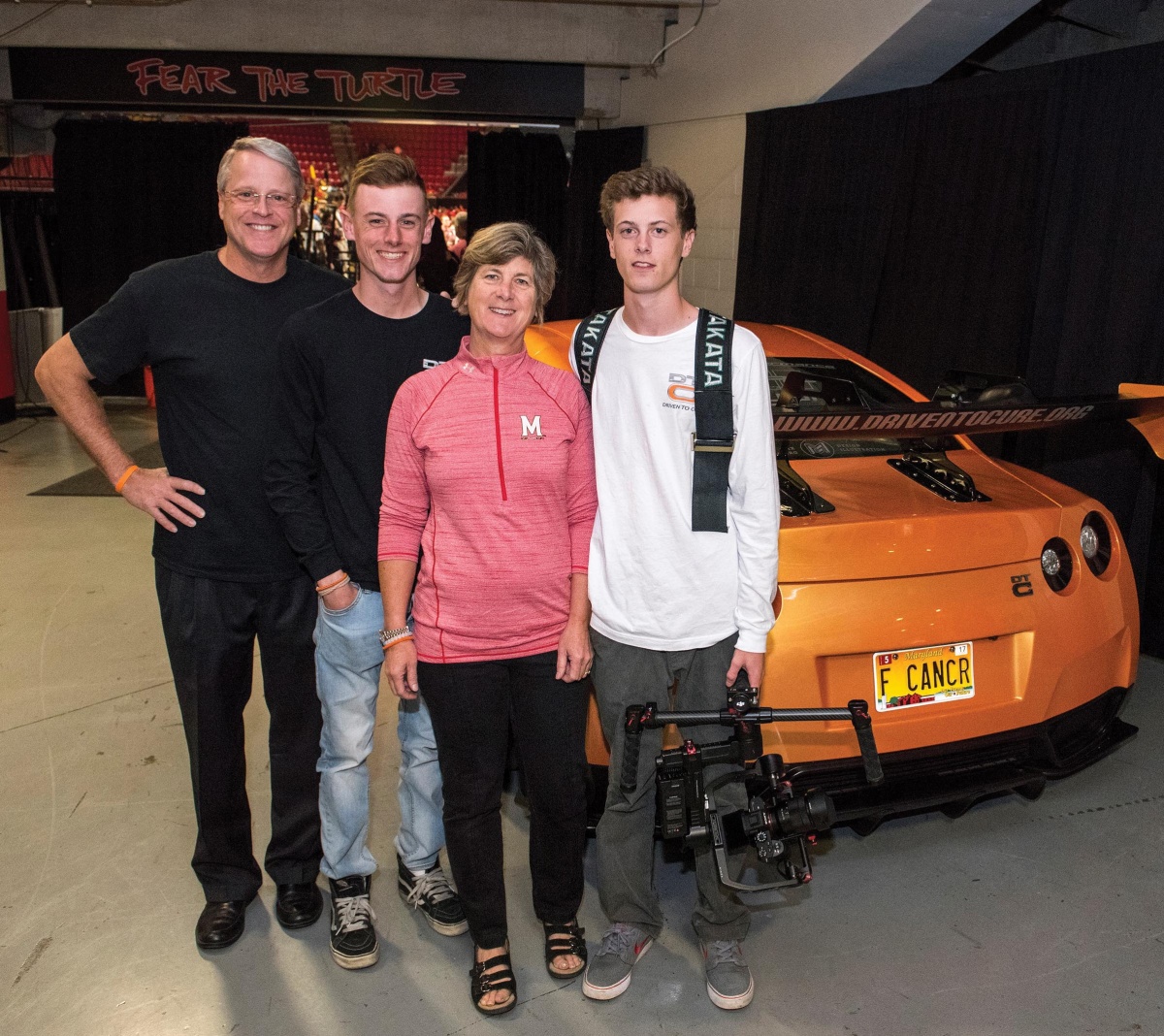
Photo credit: KEN VISSER
In spring 2019, when it was clear that Andrew was running out of time, the Lee family had some difficult decisions to make, including about whether Andrew would receive hospice care at home or in the hospital. In part because he wanted to be able to donate his living tissue for further research after his death, Andrew was admitted into the NIH’s year-old hospice unit — among the early patients to make use of it.
In addition to the donation of his kidney tissue, which is critically important for understanding HLRCC and its future treatment, Andrew allowed his hospice stay and his final hours to be photographed, and those photos used by NIH for educational purposes, training students in the pain and palliative care program. He also played a role in the development of the NIH’s canine therapy program — with a little help from Milo, the French bulldog he shared with longtime girlfriend Hailey Kellogg ’18, who became the first dog to pay an inpatient visit to the NIH hospice unit. Because NIH is a government agency (it’s a part of the U.S. Department of Health and Human Services), Milo needed to get approved before he could be brought into the facility last year. “I think he got cleared for access faster than the president of the United States,” Lee laughs.
That Lee can laugh as he remembers his son’s final days is a tribute to his own resilience, as well as the manner in which Andrew lived his life. At a June memorial service attended by nearly 1,500 people whose lives he had touched, childhood friend Michel Russo recalled Andrew’s “positivity, grit and selflessness in the midst of adversity.” Joking that Andrew must have held a Maryland state record for the most speeding tickets successfully avoided, Russo added, “but undebatable is the fact that Andrew was always, always, destined for a life of influence. The cancer didn’t change Andrew. It simply became the vehicle he used to share himself with the world.”
Proud
And then there’s Driven To Cure. Prior to Andrew’s death, the organization had received donations from an already impressive 33 countries, but within five days of his passing, that number swelled to a remarkable 160. Tributes poured in from the performance car world and elsewhere; in December, the United States’ premier car show — the Pennsylvania-based Carlisle Import and Performance Nationals — rebranded its May 2020 event as a memorial to Andrew, with proceeds bene- fitting DTC. Even now, Lee notes, he continues to field emails and phone calls from people he’s never met whose lives were touched by Andrew, and across the world, thousands of players of the popular video car game Forza have built their own versions of Andrew’s GT-R in the online platform — so many, that Driven To Cure is in talks with Forza about formalizing a licensing agreement. (In fact, the image in the opening spread of this story is not Andrew’s actual GT-R but a virtual ver- sion of the DTC car, built by a European Forza gamer.) “He’s become known globally for the work that he did to raise awareness for HLRCC and other rare kidney cancers,” Lee says. “That’s pretty incredible.”

Bittersweet as the reason for that recognition may be, Lee says DTC’s future is extremely bright. For now, it remains a grassroots operation, staffed by the Lee family and a handful of volunteers — which means nearly every dollar raised goes to research and not to operating costs. In late 2019, the organization expanded its financial support to include UCLA, where Brian Shuch, MD, one of Andrew’s doctors from Yale and NIH now heads up rare kidney cancer research; Lee presented the program with a check for $102,000 in January. Andrew’s GT-R, the expenses for which the Lee family covers privately, will be back on the road in the spring, following some much-needed reconditioning. Andrew may be gone, but his story — and that of Driven To Cure — is still unfolding. As Andrew himself said upon accepting NIH’s Charles Sanders Partnership award in 2018, “Driven To Cure is not about me. It’s about the road ahead and a lot of people making it possible for those after me to face better odds, even a cure, through biomedical research.”
Indeed, the road that Andrew envisioned is already becoming a reality. In January, Lily Cockrum, the 8-year- old from North Carolina who was at risk for HLRCC, traveled to NIH for several days of medical testing. Having helped facilitate introductions and Lily’s appointments with members of NIH’s HLRCC clinical team, Bruce Lee was on hand to support Lily and her mother, Dawn, and was among the first to hear the good news: The spot on Lily’s kidney that local doctors had suspected was an HLRCC tumor is a benign cyst. Because she has the FH mutation, however, Lily remains at risk for HLRCC, and she will now be monitored regularly by NIH — the youngest patient to enter its HLRCC protocol. If she does develop the disease, it will be caught almost immediately.
Lee would certainly be forgiven if he were to voice a little wistfulness about the Cockrums’ good fortune relative to his family’s own. But the word that he uses when he shares the story is proud. “Andrew’s goal was to raise awareness so people could diagnose and catch HLRCC early,” he says. “Driven To Cure is doing that.”
To learn more about the organization Andrew Lee ’18 started at UNH with his dream car and a devastating diagnosis, visit driventocure.org.

-
Written By:
Kristin Waterfield Duisberg | Communications and Public Affairs

















































